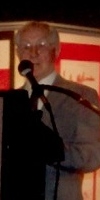PERSONAL WAR RECOLLECTIONS OF STANISLAW ROWINSKI as related on May 5th, 1990, in the Holyoke Heritage State Park program POLISH LEGACY SERIES: MARCH TO FREEDOM (Click on thumbnails for full-sized images)
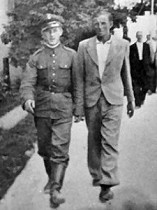 It was late summer in 1939, and my compulsory tour of duty in the
military service was about to end. It would take me a little longer, I
realized, because I decided, voluntarily, to take an auto-mechanic
course. But it was nothing compared to my two years of intensive
training. Pretty soon I'd be going home, and I wanted so much to be
back with my mother, younger brother and my three sisters! If anyone
would have told me that I would not see them again for almost thirty
years, and that I would spend the next ten years in the army, I would
have never believed it!
It was late summer in 1939, and my compulsory tour of duty in the
military service was about to end. It would take me a little longer, I
realized, because I decided, voluntarily, to take an auto-mechanic
course. But it was nothing compared to my two years of intensive
training. Pretty soon I'd be going home, and I wanted so much to be
back with my mother, younger brother and my three sisters! If anyone
would have told me that I would not see them again for almost thirty
years, and that I would spend the next ten years in the army, I would
have never believed it!
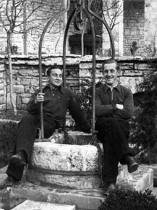 On September 1st the war began. I was assigned as a driver to the 5th
Air Force Regiment, and for a while we were transporting bombs and
aircraft equipment to airplanes in different airfields. Pretty
soon it became necessary to move entire air bases from location to
location to protect them from German bombing. The direction was mostly
eastward- clearly, we were retreating. Eventually, moving south along
the eastern Polish border and avoiding the Russian army already taking
over parts of Poland, we crossed Poland's southern border and sought
safety in Romania.
On September 1st the war began. I was assigned as a driver to the 5th
Air Force Regiment, and for a while we were transporting bombs and
aircraft equipment to airplanes in different airfields. Pretty
soon it became necessary to move entire air bases from location to
location to protect them from German bombing. The direction was mostly
eastward- clearly, we were retreating. Eventually, moving south along
the eastern Polish border and avoiding the Russian army already taking
over parts of Poland, we crossed Poland's southern border and sought
safety in Romania.
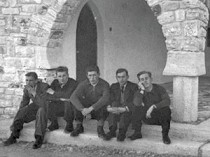 But it wasn't such a safe place, if you did not want to be taken prisoner of war by the Germans. We knew that the German
army would soon be there, too. We were interned in camps there, but not
for long. Things were rather well organized in Romania. We were
instructed to get civilian clothing and to jump freight trains at
night, hobo fashion, and go south to Constanza, where a bus was waiting
for our groups to take them to Balcik, a sea port on the Black sea.
There we soon boarded a Greek ship on its way to Beirut, where I spent
my first Christmas of the war. Pretty good, isn't it? Nobody can say the Polish underground was active in Poland only.
But it wasn't such a safe place, if you did not want to be taken prisoner of war by the Germans. We knew that the German
army would soon be there, too. We were interned in camps there, but not
for long. Things were rather well organized in Romania. We were
instructed to get civilian clothing and to jump freight trains at
night, hobo fashion, and go south to Constanza, where a bus was waiting
for our groups to take them to Balcik, a sea port on the Black sea.
There we soon boarded a Greek ship on its way to Beirut, where I spent
my first Christmas of the war. Pretty good, isn't it? Nobody can say the Polish underground was active in Poland only.
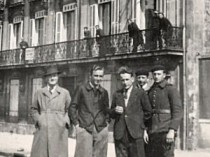 This was only the beginning of our adventure. Shortly afterwards a
French ship took us to Marseilles France, and there we were supposed
to join the western front fighters. But France was on the defensive,
too, and another evacuation was necessary. Retreating south and
moving along the Spanish border, we came to the city of St. Jean de Luz
on the Atlantic coast, where British ships picked us up and
transported us to Liverpool, England in 1940.
This was only the beginning of our adventure. Shortly afterwards a
French ship took us to Marseilles France, and there we were supposed
to join the western front fighters. But France was on the defensive,
too, and another evacuation was necessary. Retreating south and
moving along the Spanish border, we came to the city of St. Jean de Luz
on the Atlantic coast, where British ships picked us up and
transported us to Liverpool, England in 1940.
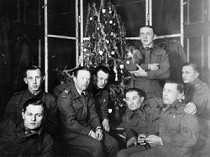 England was the place where we were organized and reorganized for
quite some time, then underwent intensive training. Beside being a
driver in a transportation unit, I was trained to be a paratrooper and
did my parachute jumps in Manchester. Then, assigned to the 10th
Polish Mounted Rifles Regiment in Scotland, I began to learn how to drive and maintain different types of tanks. At first the older ones, then the new ones, the Cromwels.
England was the place where we were organized and reorganized for
quite some time, then underwent intensive training. Beside being a
driver in a transportation unit, I was trained to be a paratrooper and
did my parachute jumps in Manchester. Then, assigned to the 10th
Polish Mounted Rifles Regiment in Scotland, I began to learn how to drive and maintain different types of tanks. At first the older ones, then the new ones, the Cromwels.
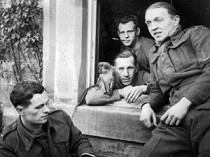 Finally, things began to happen. Some time in May, 1944, our tanks had five digit numbers painted on them, were loaded onto trains, and transported to the south shore of England, with their crews following them, of course. When we manned the tanks again we were instructed to drive them along a certain road until we found spots marked with the same numbers that appeared on our tanks, and park them there. In this way the whole regiment was put in a definite order and was ready for action. Around the area huge amounts of ammunition were stored, and we knew that something important was about to take place. When radio silence was imposed (using the tanks' radios was forbidden) we knew for sure we were about to invade Europe!
Finally, things began to happen. Some time in May, 1944, our tanks had five digit numbers painted on them, were loaded onto trains, and transported to the south shore of England, with their crews following them, of course. When we manned the tanks again we were instructed to drive them along a certain road until we found spots marked with the same numbers that appeared on our tanks, and park them there. In this way the whole regiment was put in a definite order and was ready for action. Around the area huge amounts of ammunition were stored, and we knew that something important was about to take place. When radio silence was imposed (using the tanks' radios was forbidden) we knew for sure we were about to invade Europe!
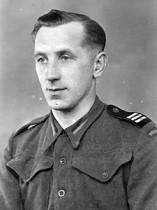 As soon as the Caen bridgehead was established, we crossed the English
Channel and went into action. The 10th Polish Mounted Rifles
Regiment was a reconnaissance unit for the First Polish Armoured
Division, so we had to be very disciplined, calm, and collected;
especially during radio communications. The entire division depended
on information gathered by us. So, it didn't come as any surprise to
the other units when our radio operator reported calmly and matter-of-factly:
"Signing off the air for a while, our tank is on fire. Over."
As soon as the Caen bridgehead was established, we crossed the English
Channel and went into action. The 10th Polish Mounted Rifles
Regiment was a reconnaissance unit for the First Polish Armoured
Division, so we had to be very disciplined, calm, and collected;
especially during radio communications. The entire division depended
on information gathered by us. So, it didn't come as any surprise to
the other units when our radio operator reported calmly and matter-of-factly:
"Signing off the air for a while, our tank is on fire. Over."
The fact was that being always first, we got in a lot of hot water and took part in many battles. Some of them I remember quite vividly. Like Jort, on August 15th, 1944. Our platoon, consisting of three tanks, was ordered to check if any German units were hiding behind some tall hedges bordering the farm fields ahead of us. I drove my tank slightly over the hedge to obtain better visibility, our radio operator reported two German tanks, and immediately we were under fire. They overshot my tank the first time, and I had just managed to back out in snake-like fashion, when another shell burst right where my tank was only seconds ago! The other two tanks were not so lucky - they were hit. The commander of the one on the right was killed, and the tank on the left caught fire. I watched the gunner of this tank pushing out his wounded commander through the turret top, and then getting out himself. Both were very badly burned. We were assigned replacements, but eventually, after other risky missions, mine was the only tank left - and my platoon ceased to exist. I became a replacement for another platoon.
The most important mission that my regiment accomplished was closing the so-called Gap at Falaise. The escape route of the German Panzer Division, some 50,000 strong, had to be blocked. The Americans and the Canadians were closing in on them, but there was still a gap between the two armies, a gap through which the Germans could escape. The First Polish Armoured Division was ordered to block that gap. After a three day long battle at Chambois (about 20 miles east of Falaise, and one of the most fierce battles of this war), this ring was closed and the Germans surrendered.
Some historians, including General Omar Bradley who was the chief commander in Europe - and therefore should know better - ignore the Polish contribution to the victory. But they cannot fool me! As Carlo D'Este reported in his 1985 book, "...elements of the 10th Polish Mounted Rifles Regiment joined the U.S. 90th Division and the Trun-Chambois gap was closed..." One of the "elements" was the tank driven by me. I was there!
We moved on. At Ypres, September 1944, I remember seeing a monument with a sign written in Dutch: NO MORE WAR! No more war? We were fighting one! The sign, of course, referred to the previous war, when poisonous gas was used in this area. In Poland this gas is known as "iperyt", a name obviously derived from the name of this old city. No more wars, the eternal hope of mankind!
We moved on again. Roulers, Axel, Merxplas, Zondereigen, and Ghent,liberating the cities as we went ahead. What a wonderful feeling seeing all those happy people waving Polish flags (how did they know that we were Polish?), showering us with flowers, and distributing bottles of wine! The bitter part of it being that the road to our own country was still closed, and remained so, even after the war - when the communist government was forced upon Poland!
Then there came Breda.. a difficult fight because of the decision of the Polish army to spare the ancient city and its inhabitants. Breda was taken on October 30th, 1944. The night attack surprised the Germans, and after a heavy, two-day fight, the city was free and relatively unharmed. Grateful Breda bestowed honorary citizenship on the whole First Polish Armoured Division, and presented General Maczek with the key to the city!
We did not stay for the festivities - right away we headed northwest to cross the river Mark and take Moerdijk, a city protected by canals, purposely flooded plains, and mine fields. Concrete walls across the roads leading to the city added to the impenetrability. General Franciszek Skibinski was in charge of the attack - a very tough task, indeed! He used our regiment for reconnaissance "...on which", he said, "you could depend in any circumstances." We were also instrumental in destroying the concrete wall on our road using anti-armor charges in our tanks' guns. General Skibinski also admired our regiment for not having any missing-in-action soldiers. "Why-",he would say, "the whole regiment, 60 tanks strong, would go, if necessary, to rescue one wounded comrade!"
I did not stay in Europe till the end of the war - I was sent to England to be trained in the use of the newest tank, the Comet, a tank which never saw battle. The war ended before my training period was over. I did not know at the time, but during its victorious march north, my division liberated a unique prisoner-of-war camp. It was the camp in Oberlangen where the participants of the Warsaw Uprising, all women, were imprisoned. After returning to my unit, which was stationed not far from it, I went there to check the list of names hoping that I might find someone I knew. I did not, but I met my future (and present) wife.
Conquered after the cease-fire! After fighting for ten years for freedom, I lost my own. What a way to end the war!

